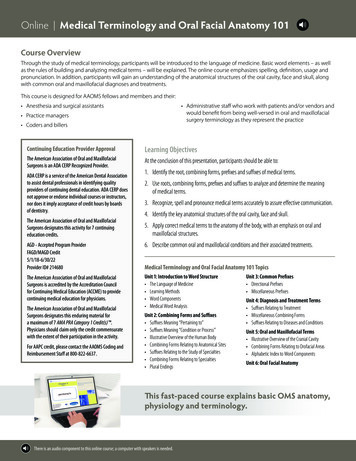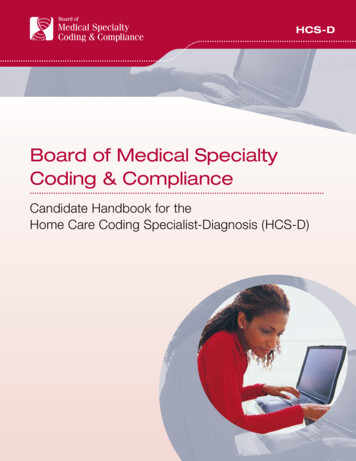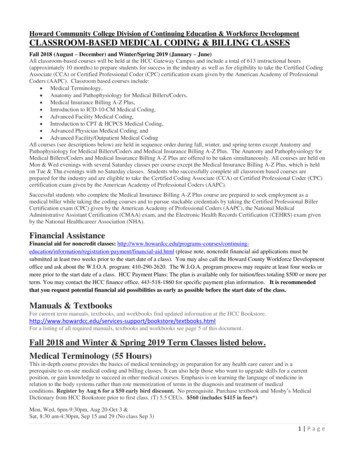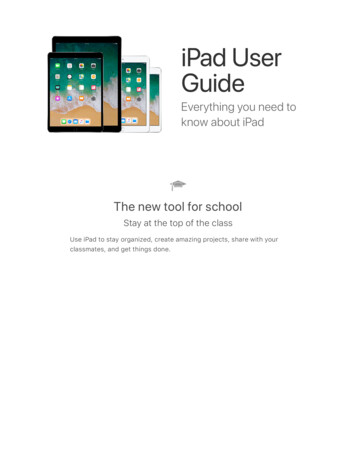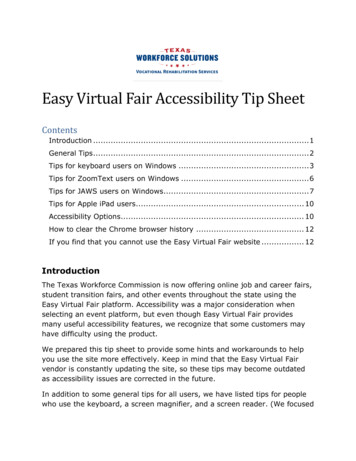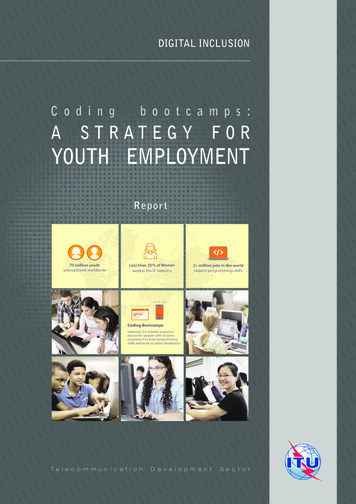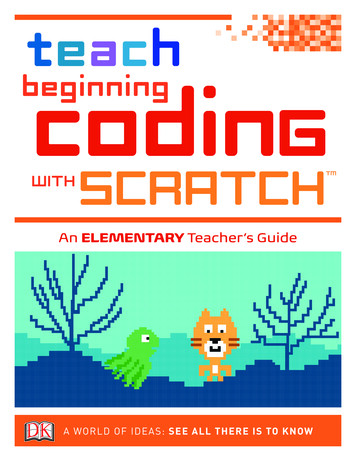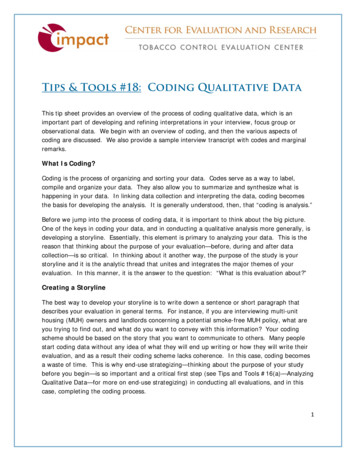
Transcription
Tips & Tools #18: Coding Qualitative DataThis tip sheet provides an overview of the process of coding qualitative data, which is animportant part of developing and refining interpretations in your interview, focus group orobservational data. We begin with an overview of coding, and then the various aspects ofcoding are discussed. We also provide a sample interview transcript with codes and marginalremarks.What Is Coding?Coding is the process of organizing and sorting your data. Codes serve as a way to label,compile and organize your data. They also allow you to summarize and synthesize what ishappening in your data. In linking data collection and interpreting the data, coding becomesthe basis for developing the analysis. It is generally understood, then, that “coding is analysis.”Before we jump into the process of coding data, it is important to think about the big picture.One of the keys in coding your data, and in conducting a qualitative analysis more generally, isdeveloping a storyline. Essentially, this element is primary to analyzing your data. This is thereason that thinking about the purpose of your evaluation—before, during and after datacollection—is so critical. In thinking about it another way, the purpose of the study is yourstoryline and it is the analytic thread that unites and integrates the major themes of yourevaluation. In this manner, it is the answer to the question: “What is this evaluation about?”Creating a StorylineThe best way to develop your storyline is to write down a sentence or short paragraph thatdescribes your evaluation in general terms. For instance, if you are interviewing multi-unithousing (MUH) owners and landlords concerning a potential smoke-free MUH policy, what areyou trying to find out, and what do you want to convey with this information? Your codingscheme should be based on the story that you want to communicate to others. Many peoplestart coding data without any idea of what they will end up writing or how they will write theirevaluation, and as a result their coding scheme lacks coherence. In this case, coding becomesa waste of time. This is why end-use strategizing—thinking about the purpose of your studybefore you begin—is so important and a critical first step (see Tips and Tools #16(a)—AnalyzingQualitative Data—for more on end-use strategizing) in conducting all evaluations, and in thiscase, completing the coding process.1
Why is developing a storyline so important to the coding process? It will help you decide what concepts and themes you want to communicate in yourevaluation. It guides you in how your data should be organized and coded. It gives you the basic structure for your coding scheme.Code Your DataCoding can be done in any number of ways, but it usually involves assigning a word, phrase,number or symbol to each coding category. You will go through all your textual data (interviewtranscripts, direct notes, field observations, etc.) in a systematic way. The ideas, concepts andthemes are coded to fit the categories.Creating CodesThe process of creating codes can be both pre-set and open. We recommend a hybrid, usingboth these two models. Before beginning data collection and the coding process, it is good tobegin with a “start list” of pre-set codes (often referred to as “a priori codes”). These initialcodes derive from the conceptual framework, list of research questions, problem areas, etc.Your prior knowledge of the subject matter and your subject expertise will also help you createthese codes. For instance, if you are interviewing MUH owners and managers, you may alreadythink about the codes “economic issues” or “tenant smoking” or “common areas” (the list couldgo on and on. At a later time, the codes “economic issues” and “tenant smoking” may becollapsed into a larger code or theme of “barriers to policy.”Pre-Set CodesA pre-set list can have as little as 10 codes or up to 40-50 codes. We recommend not creatingtoo many codes because the person coding can become overwhelmed or make mistakes in thecoding process if there are too many. In creating these codes, it is important to create a “codebook,” which is list of the codes and what they mean.Emergent CodesWhile it is good to begin data collection and coding with pre-set codes, another set of codes willemerge from reading and analyzing the data. These “emergent codes” are those ideas,concepts, actions, relationships, meanings, etc. that come up in the data and are different thanthe pre-set codes. For instance, in the aforementioned example of interviews of MUH ownersand managers, the issue of tenants smoking medicinal marijuana may have come up. This maybe seen as a tricky legal issue by the owners and managers. It may have been something notcoded before data collection and coding began. So, the text discussing this issue could be2
coded as “legal issue” (which was probably identified as a start code) and “medicinalmarijuana.” Because there’s a good chance that medicinal marijuana was not a start code, it isadded to the code book as an emergent code. In many cases, the “surprise” emergent codesform the basis of interesting stories and may indeed become part of the major storyline told inyour evaluation.Coding as a System of Organizing Your DataOne easy way to think about coding is to see it as a system to organize your data. In essence,it is a personal filing system. You place data in the code just as you would file something in afolder. A systematic way to code data is to ask yourself the following questions as you read thetext: What is this saying? What does it represent? What is this an example of? What do I see is going on here? What is happening? What kind of events are at issue here? What is trying to be conveyed?The word, number or symbol that you assigned to the item of data in answering such questionsis a code. These are labels that classify items of information. We recommend using words orphrases as codes and in your marginal notes for later ease of analysis (sometimes numbers andsymbols can be confusing).Refining Your CodesIt is important to note that as your data are coded, the coding scheme will be refined.Meaning, you will add, collapse, expand and revise the coding categories. This is especially trueof the pre-set codes. Oftentimes, what one expects to find in the data is not there. It happens.Moreover, some codes simply do not work or conflate other ideas from different codes.Alternatively, sometimes codes flourish in a way that there is too much data. In this case, thecode needs to be broken down into sub-codes in order to better organize the data. The rule ofthumb for coding is to make the codes fit the data, rather than trying to make your data fit yourcodes.Coding “Notes”Finally, as part of the process of coding, it is important to jot down notes of your reactions andideas that emerge. These ideas are important and vital to the analytic process. These notes3
may suggest new interpretations, as well as connections with other data. Moreover, if you aremindful of what is growing out of the data, your notes will usually point toward questions andissues for you to look into as you code and collect more data.Illustration of Coding and Marginal RemarksFigure 1 is an example of the initial coding and marginal remarks on a hard copy of interviewtranscripts. Typically, in an interview transcript like the one shown (Figure 1), you will read theentire interview from start to finish without coding. On the second read, you will want to jotdown both codes and remarks on a hardcopy as you read it. As mentioned previously, thecodes will derive from both those created prior to data collection (“pre-set codes,” also referredto as “a priori codes”), as well as those that are created as data are collected and transcriptsare reviewed (referred to as “emergent codes”).4
After the initial coding, Word files need to be created based on your codes. Think of thisprocess as cutting and pasting the quotes on a poster board (how people did it on the good ol’days!). The marginal notes will also come in handy when thinking about how the codes fittogether. Thus, in Figure 1, we have the codes “hands on activities” and “reaction.” Aftergoing through a handful of the interviews and rereading our marginal notations, we see thatthese codes are part of a larger theme of “onsite learning vs. webinar.” At a later point, wethus collapsed the codes into a larger theme and can discuss various aspects of onsite learningand contrast it with remote (webinar) learning. We can compare these two major ideas basedon our data. Moreover, within “onsite learning” we may compare participants’ views in order toshow the complexity of the analysis. Our coding process will thus enable us to show therichness, complexities and contradictions of the social milieu we are evaluating, which is thebasis of qualitative methods.References:Gibbs, Graham. 2007. Analyzing Qualitative Data.Lofland, John, and Lofland, Lyn H. 1995. Analyzing Social Settings: A Guide to QualitativeObservation and Analysis. Wadsworth Publishing Company: B elmont, CA.Miles, Matthew B., and Huberman, Michael A. 1994. Qualitative Data Analysis.Taylor, S.J. and Bogdan, R. (1998). Introduction to Qualitative Research Methods. Wiley andSons: Hoboken, NJ.5
Tips & Tools #18: Coding Qualitative Data This tip sheet provides an overview of the process of coding qualitative data, which is an . Introduction to Qualitative Research Methods. Wiley and Sons: Hoboken, NJ. Title: Microsoft Word - Tips and Tools #18 - Coding Qualitative Data _2012.doc Author: dianad Created Date: 7/9/2012 2:39:24 PM .

